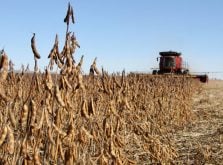NIVERVILLE, Man. – Although he’s reluctant to say it out loud, based on the activity at Lorne Loeppky’s farmyard, it’s clear he’s expecting a good harvest this fall.
Loeppky, who is growing 3,200 acres of corn, canola, soybeans and winter wheat on his farm this year, was busy last week installing old grain bins onto four new hoppers.
“It’s been excellent weather for canola (and soybeans), but it’s not in the bin yet,” said Loeppky, while he watched a crew of four workers attempting to get a steel bin to fit snugly on a hopper on his farm near Niverville.
Read Also

Manitoba extends Crown land rent freeze
Manitoba government links the continued rental rate freeze on grazing and forage leases to economic and environmental challenges facing the industry
While his canola and soybeans are looking great, Loeppky said his 900 acres of corn could use a warm August to boost the crop’s development.
He estimated that the corn is seven to 10 days behind normal, which is not surprising, given Manitoba’s cool summer so far.
According to data from Environment Canada, the Winnipeg airport weather station did not register one day above 30 C in June and July. The closest it came was June 30, when the thermometer hit 29.7 C.
“Normally by this time you would’ve had a few days over 30,” said Bob Cormier, a meteorologist with Environment Canada.
In a more typical July, the average daily high temperature is 25.8 C. This July, based on data up to July 24, the average high was 23.9 C.
As further evidence of how cool it’s been in the Red River Valley, Loeppky said he found a wood tick crawling on him in late July, an insect that normally disappears much earlier in the summer.
Wood ticks aside, Loeppky’s bigger concern is a slow developing corn crop, which increases the risk of frost.
“We can’t have any frost before Sept. 30, otherwise we’re not going to have a quality product,” said Loeppky, who noted that other than frost, corn is a “trouble free” crop in the Red River Valley.
“With corn, there’s no fusarium problem,” said Loeppky, who then turned his attention back to a crane holding up the grain bin.
In addition to minimal disease difficulties, the record corn prices are a nice bonus for Manitoba producers, who planted more corn than last year.
“Crop insurance numbers put us at 204,309 grain acres (seeded),” said Manitoba Corn Growers Association secretary-manager Theresa Bergsma.
“Last year was 187,000 (acres) … and 2006 was 150,000.”
Loeppky avoids the most expensive aspect of growing corn, the cost of nitrogen, because he is also a pig producer. He has 1,500 sows and 6,000 feeder pigs in barns a kilometre north of his farmyard, and the hog manure provides enough fertilizer to cover all his corn acres
When asked about the state of Manitoba’s hog industry, which has been battered by high feed costs, U.S. country-of-origin labelling laws and a provincial government moratorium on expansion, Loeppky provided a pragmatic response.
“A few years ago we had $3.65 (per bushel) corn and the hog farming was paying for the land farming,” he said.
“Now, land farming is helping out the pig farmer.”















